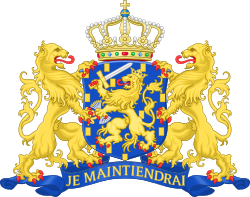District Members elected Group Ref. Alkmaar Jacob Leonard de Bruyn Kops Liberal [ 3] Cornelis van Foreest [ Note 1] Conservative [ 4] Almelo Jacob Kalff Conservative [ 5] Gijsbertus Martinus van der Linden Thorbeckian liberal [ 6] Amersfoort Jan Karel van Goltstein [ Note 1] Conservative [ 7] E.L. van Hardenbroek van Lockhorst [ Note 1] Conservative [ 8] Amsterdam Michel Henry Godefroi [ Note 1] Conservative liberal [ 9] Herman Albrecht Insinger [ Note 1] Conservative [ 10] Gerlach Cornelis Joannes van Reenen [ Note 1] Conservative [ 11] Menso Johannes Pijnappel [ Note 1] Conservative liberal [ 12] Jan Jacob Rochussen Conservative [ 13] Jan Heemskerk Bzn. [ Note 1] Thorbeckian liberal [ 14] Appingedam Derk de Ruiter Zijlker Liberal [ 15] Rembertus Westerhoff [ Note 1] Thorbeckian liberal [ 16] Arnhem L.A.J.W. Sloet van de Beele Thorbeckian liberal [ 17] Willem Hendrik Dullert [ Note 2] Thorbeckian liberal [ 18] Assen Johan Rudolph Thorbecke [ Note 1] Thorbeckian liberal [ 19] Lucas Oldenhuis Gratama [ Note 1] Liberal [ 20] Boxmeer H.C.F. Kerstens [ Note 1] Pragmatic liberal [ 21] Breda Norbertus Reinerus Henricus Guljé [ Note 1] Thorbeckian liberal [ 22] P.J.J. Hollingerus Pijpers [ Note 1] Thorbeckian liberal [ 23] Delft Johannes van Kuijk Conservative [ 24] Johannes Leonardus Nierstrasz Conservative [ 25] Den Bosch J.M.B.J. van der Does de Willebois Conservative (Catholic) [ 26] F.J.E. van Zinnicq Bergmann [ Note 1] Conservative (Catholic) [ 27] Den Haag François de Casembroot [ Note 1] Conservative [ 28] Cornelis Ascanius van Sypesteyn Conservative [ 29] Deventer Albertus van Delden [ Note 1] Thorbeckian liberal [ 30] Gerard Dumbar [ Note 1] Thorbeckian liberal [ 31] Dokkum Philippus van Blom [ Note 1] Thorbeckian liberal [ 32] Sybrand van Beyma thoe Kingma [ Note 1] Liberal [ 33] Dordrecht Pieter Blussé van Oud-Alblas [ Note 1] Thorbeckian liberal [ 34] Pieter Philip van Bosse Liberal [ 35] Eindhoven Johannes Baptista Bots [ Note 1] Thorbeckian liberal [ 36] Petrus Johannes Antonius Smitz Conservative (Catholic) [ 37] Goes Pieter Hendrik Saaymans Vader [ Note 1] Anti-revolutionary [ 38] Gorinchem Warnardus Cornelis Mathildus Begram [ Note 1] Conservative [ 39] Gerrit Simons [ Note 1] Conservative [ 40] Gouda Willem Maurits de Brauw [ Note 1] Conservative [ 41] Mari Aert Frederic Henri Hoffmann [ Note 1] Conservative [ 42] Groningen Johan Herman Geertsema Liberal [ 43] Haarlem Willem van der Hucht [ Note 1] Conservative [ 44] Daniël Koorders Conservative [ 45] Hoorn Jeronimo de Bosch Kemper Conservative [ 46] Willem van Goltstein van Oldenaller [ Note 1] Conservative [ 47] Leeuwarden J.K.H. de Roo van Alderwerelt [ Note 1] Liberal [ 48] Sybrand Hingst [ Note 1] Liberal [ 49] Leiden P.H. Taets van Amerongen tot Natewisch [ Note 1] Conservative [ 50] Otto van Wassenaer van Catwijck [ Note 1] Anti-revolutionary [ 51] Maastricht Ch.A. de Bieberstein Rogalla Zawadsky [ Note 1] Thorbeckian liberal [ 52] P.Th. van der Maesen de Sombreff [ Note 1] Thorbeckian liberal [ 53] Middelburg Daniël van Eck [ Note 1] Thorbeckian liberal [ 54] Gerrit Adriaan Fokker Thorbeckian liberal [ 55] Nijmegen Christianus Joannes Antonius Heydenrijck [ Note 1] Conservative (Catholic) [ 56] Joannes van Nispen van Sevenaer [ Note 1] Pragmatic liberal [ 57] Roermond Karel Lodewijk Joseph Cornelis Thorbeckian liberal [ 58] Leopold Haffmans Conservative (Catholic) [ 59] Rotterdam François Willem Cornelis Blom [ Note 1] Liberal [ 60] Isaäc Dignus Fransen van de Putte [ Note 1] Liberal [ 61] Willem Adriaan Viruly Verbrugge [ Note 1] Liberal [ 62] Sneek Antony Moens [ Note 1] Liberal [ 63] Schelte Wybenga [ Note 1] Liberal [ 64] Steenwijk Carel Marius Storm van 's-Gravesande [ Note 1] Liberal [ 65] Tiel Willem Frederik Carel van Lidth de Jeude [ Note 1] Conservative [ 66] Tilburg Ferdinandus Hendricus Hubertus Borret Conservative (Catholic) [ 67] J.B.A.J.M. Verheyen [ Note 1] Conservative (Catholic) [ 68] Utrecht Evert du Marchie van Voorthuysen [ Note 1] Conservative [ 69] Nicolaas Pieter Jacob Kien [ Note 1] Conservative [ 70] Winschoten Willem Jonckbloet Liberal [ 71] Zierikzee Jacob Johan van Kerkwijk [ Note 1] Liberal [ 72] Zuidhorn Geert Reinders [ Note 1] Pragmatic liberal [ 73] Zutphen Jacob Dam [ Note 1] Thorbeckian liberal [ 74] Lambertus Eduard Lenting Thorbeckian liberal [ 75] Zwolle Jan Willem Gefken Anti-revolutionary [ 76] Albertus van Naamen van Eemnes [ Note 1] Liberal [ 77] 
